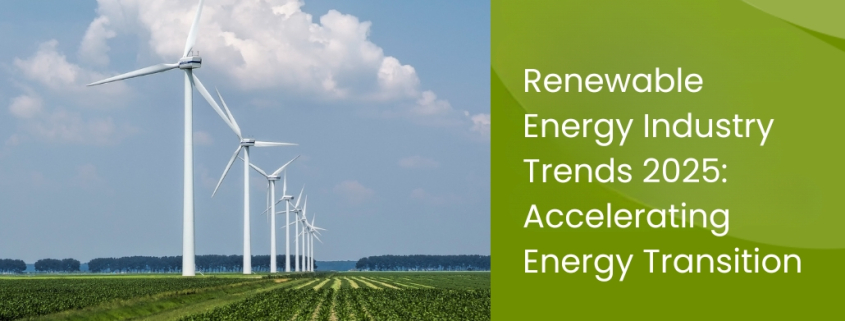Renewable Energy Industry Trends 2025: Accelerating Energy Transition
Renewable energy has gained significant momentum in recent years, driven by the need to reduce carbon emissions. In 2025, several key trends are expected to redefine the energy landscape, how energy is produced, distributed, and consumed.
Rising power demands, geopolitical shifts, digital advancements, and an increasing move towards incorporating renewable energy will redefine how the world produces, manages, and consumes energy.
From notable energy trends, such as solar and wind, to decentralised energy systems based on localising energy generation to utilising biomass and waste for generating energy, the renewable energy sector is embracing a mix of solutions for energy security.
This blog looks at notable trends expected to shape the renewable energy sector in 2025.
Trends to shape the renewable energy sector in 2025
Several clean energy trends are expected to shape the future of the renewable energy industry. Here are some of the strategic trends:
1. Renewables to drive carbon management
Renewables now serve as the core to carbon management strategies. According to a recent report by Deloitte, 72% of organisations have implemented strategies to reduce or help their customers reduce carbon emissions, primarily to meet sustainability goals.
However, most respondents with partial integration faced a learning curve challenge. This indicates there are opportunities for better renewable energy implementation strategies and knowledge transfer.
Renewables contribute to high-integrity carbon management solutions in two ways: by powering direct air capture (DAC) infrastructure and by providing an emerging carbon dioxide removal (CDR) approach.
2. A mix of solutions to address clean energy transition
Energy experts support an integrated and diversified portfolio approach to energy solutions. These solutions include energy storage systems, advanced nuclear technologies, clean fuels, hydrogen applications, and carbon removal solutions.
No technology will solve the energy transition alone; a mix of solutions will be needed. Moreover, resource availability based on regions, regulatory frameworks based on different industries, and the existing infrastructure of different businesses necessitate a tailored energy solutions approach. This also opens opportunities for collaboration between energy solutions providers and organizations to accelerate the clean energy transition.
3. Biomass energy power plants expansion and integration
Another evolving renewable energy trend is the rapid and widespread adoption of biomass as a clean energy source. Utilising organic materials—including waste from plants, wood, animals, waste products, agricultural residues, and municipal solid waste—biomass energy is playing a crucial role in reducing reliance on fossil fuels.
Asian markets, particularly India and China, are increasingly exploring biomass utilisation. Other regions, such as Europe and Latin America are expected to adopt more ambitious bioenergy and biomass programs. Both public and private sectors are directing investments in biomass energy systems to meet their carbon reduction goals and to address the growing energy demands.
4. A transition from fossil fuel dependency
While fossil fuels still remain a considerable part of the world’s energy mix, its use continues to decline as renewable energy sources keep getting more cost-effective. As biomass, wind, and solar become more cost-competitive, the dependence on fossil fuels will decline.
While a considerable shift will take a long time, a sufficient increase in biomass recapture and utilisation could dramatically reduce fossil fuel use. Energy producers are under increasing pressure to move away from fossil fuels. As renewable energy sources become cheaper, more reliable, and accessible, the industry will naturally transition to cleaner options.
5. Energy, economy and manufacturing sectors align
Governments, industries, and populations are increasingly prioritising energy security, cost-efficient power sources, lowering carbon emissions, and adopting alternative and renewable energy sources. This new emerging energy economy presents significant opportunities, connecting energy solutions providers, manufacturing industries, and the economy.
It is expected that in 2025, governments will further shape energy transition policies to support their industrial and economic ambitions with more integrated policies targeting jobs, investment and advanced energy investments’ broader economic impact.
6. Employment and job transformation in the renewable energy sector
The acceleration of renewable energy infrastructure will continue to generate employment growth. According to the Deloitte report, clean energy jobs accounted for more than half of energy jobs created in 2023 and 79% of new electric power generation jobs; these jobs grew at twice the rate of employment across the economy, while energy construction jobs grew at twice the rate of all construction jobs. Hiring in renewables has grown to twice the level of hiring in fossil fuels, underlining its potential for job creation.
The utility industry, which has the most significant share and demand for green skills—led by renewable energy and electrification, is in fierce competition with the technology industry. With its rapid growth, the technology industry is also driving the demand for green skills.
Renewable energy: strategic outlook for 2025
2025 will see various efforts in the energy ecosystem to overcome challenges and fill gaps between supply and demand for clean energy. Multiple factors will influence the renewable energy sector’s continuous development. Factors such as:
- Industrial policy and regulatory framework changes
- Government initiatives and incentives
- Private sector investments
- Contributions from energy solutions and technology companies
- Increased commitment to sustainability across stakeholder groups
- Low-cost energy solutions
Uttamenergy is committed to contributing to energy security and clean energy goals with solutions including biomass energy, waste-to-energy, co-generation plants, captive power plants, and biomass-based independent power plants. The company has delivered high-quality renewable energy power plant solutions to various industries, including sugar, chemical, power, ethanol, and manufacturing. By leveraging innovative technologies and high-quality engineering, Uttamenergy is poised to play a significant role in shaping the future of renewable energy. If you’re looking for renewable energy solutions, contact Uttamenergy.



